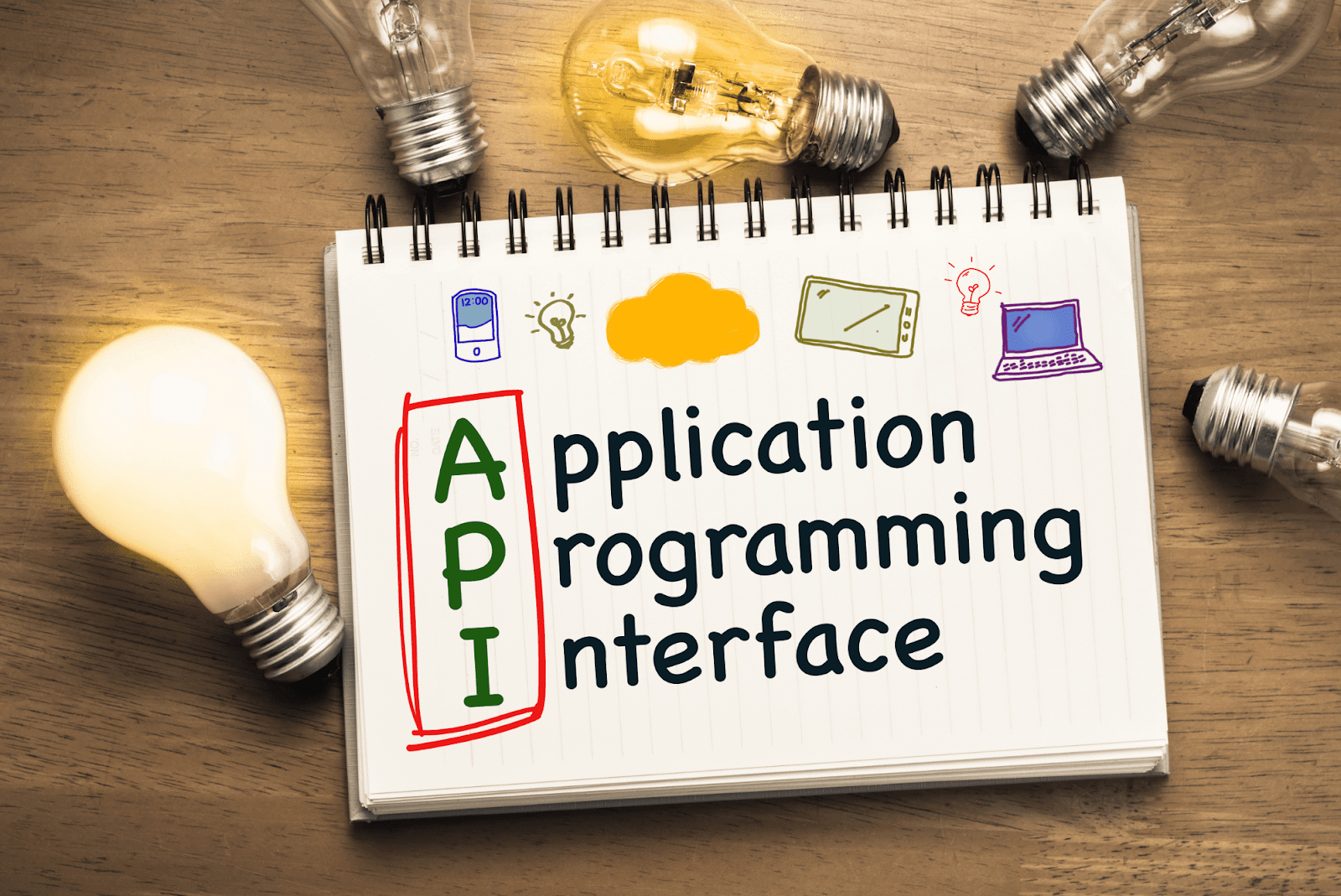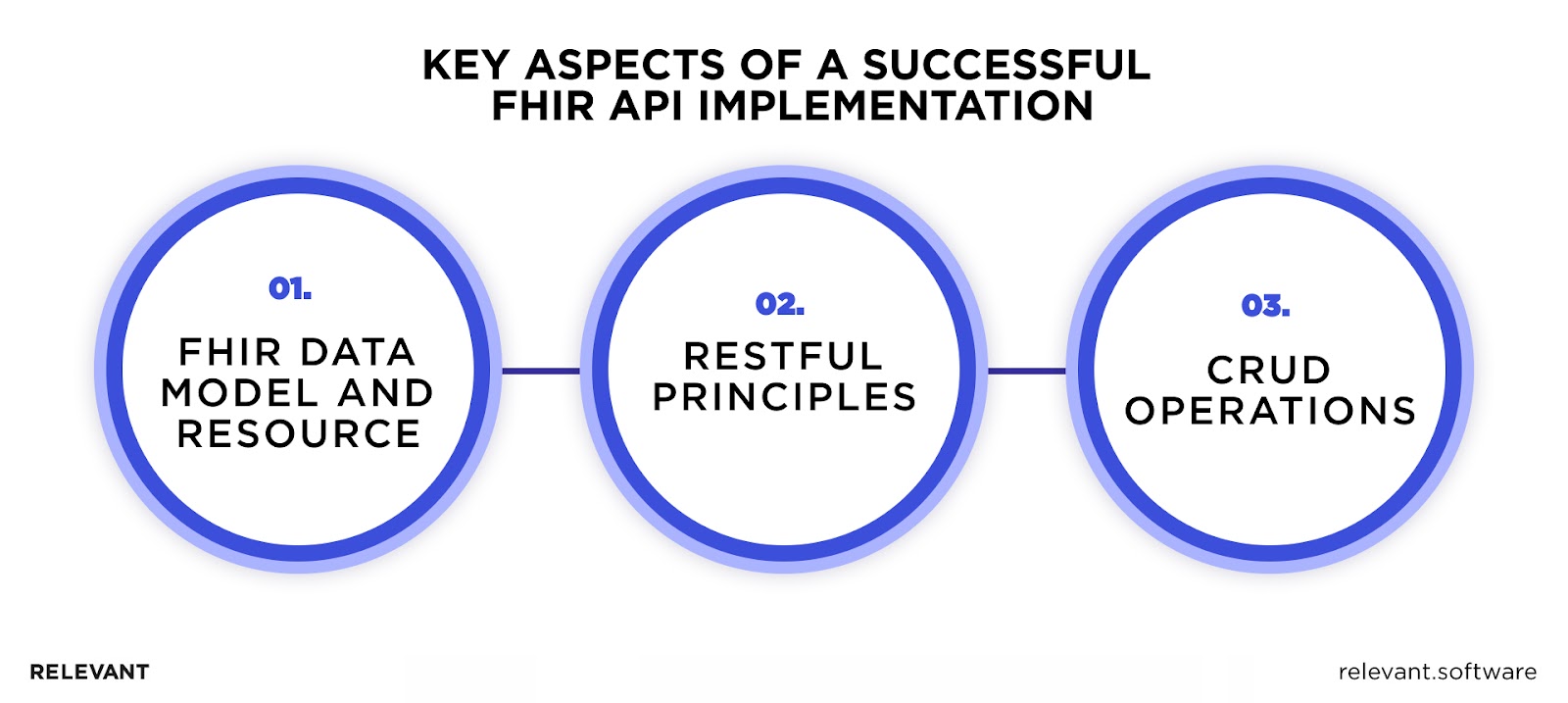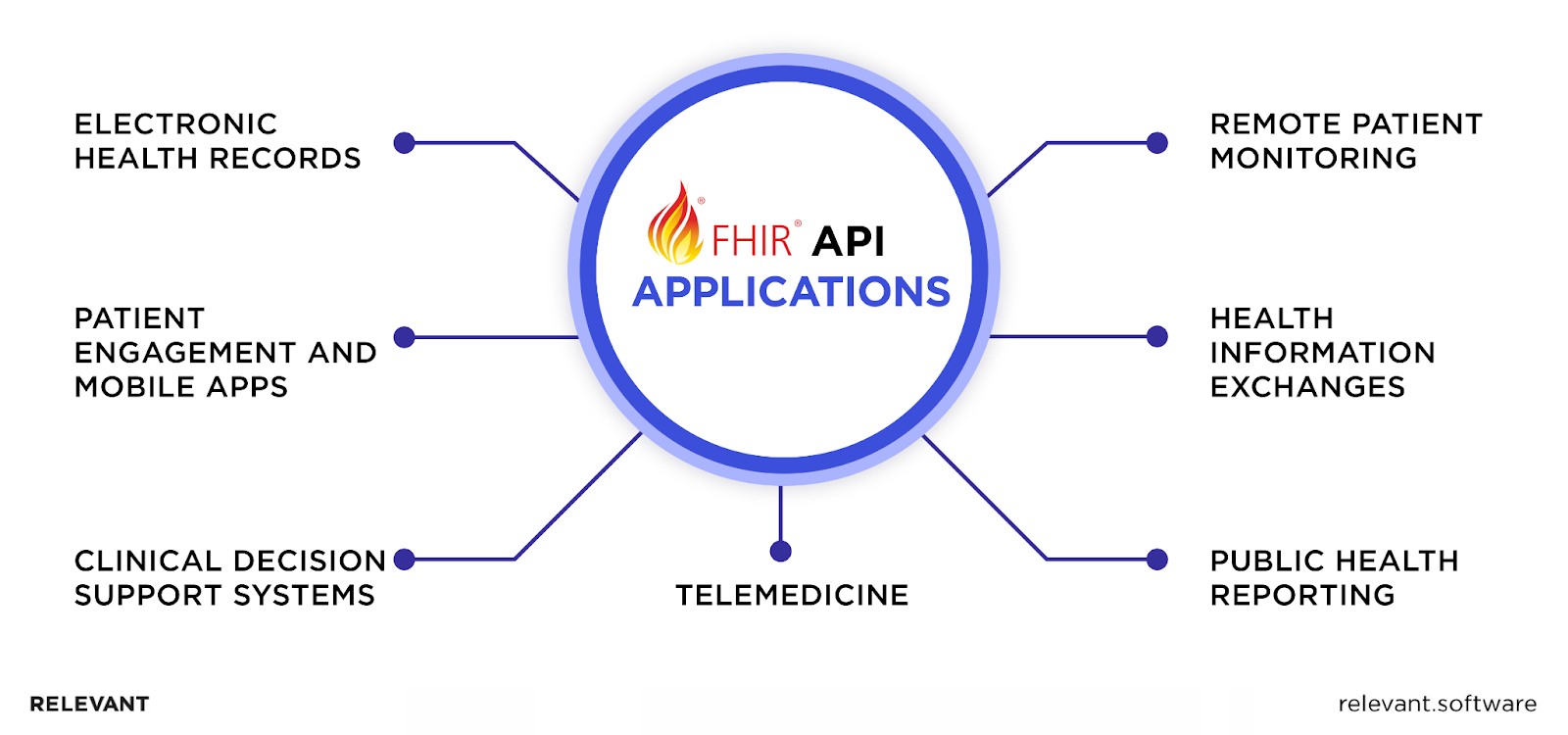Interoperable Health Solutions Begin with FHIR APIs
Updated: June 4, 2025
Many healthcare organizations are still confronting difficulties integrating information between different systems. Well, considering that the healthcare industry generates nearly 30% of global data, it’s not surprising the accessibility and exchange of this data remain a challenge. In fact, it’s the main obstacle that doesn’t let your business become a data-driven organization. The FHIR healthcare standard can help you reach the desired data interoperability. One way it helps streamline data exchange is through the FHIR APIs, which enable you to extract and integrate extensive data volumes.
In this guide, we’ll look closely at what is a FHIR API, how it works, and the ways it can help healthcare organizations benefit from an easy data exchange.

We provide companies with senior tech talent and product development expertise to build world-class software. Let's talk about how we can help you.
Contact usTable of Contents
The Need for Standardization in Health Data
Diverse data formats, data silos, and the lack of a common language have long hindered the seamless exchange of health information, making data management expensive and time-consuming. Amidst the accelerating digital transformation in healthcare, organizations have realized the critical need for a unified data model for their healthcare software solutions.

Consider a patient with a chronic condition moving across states. Without standardization, their medical history could become a patchwork of incompatible records that could potentially lead to misinformed medical decisions. The FHIR standard mitigates such risks by offering a structured format for health data exchange. It helps eliminate fragmentations, duplications, and ambiguities of different data formats to ensure your systems accurately understand, interpret, and use that information.
What is an API?
An API, or Application Programming Interface, is a gateway that enables one computer program or system to tap into the functionalities and data of another. It lays out the specifications for how data should be structured and the range of acceptable interactions, such as the methods for querying data.

Consistency in data formatting is paramount to ensure successful exchange and operability. For instance, a data field designated for calculations must have a uniform input, as “1” and “one” hold different interpretations. APIs can range from simple, with strict data structure definitions, to complex, accommodating varied data structures for numerous interactions.
APIs are integral to both desktop and mobile applications for retrieving, updating, and storing data. Take, for example, a healthcare app that uses APIs to access a user’s medical records from different healthcare providers. Each API platform establishes the standards and protocols for external applications to access the provider’s data, adhering to the necessary security measures. Through API management services, the app can securely request, aggregate, and offer a consolidated view of the user’s data from different sources.
What are FHIR APIs?
FHIR, or Fast Healthcare Interoperability Resources, is a framework based on HL7 standards and designed to simplify data sharing in the medical sector. By creating a universal set of APIs, FHIR makes the information understandable across diverse healthcare platforms and ensures they can communicate effectively. The primary function of an FHIR API is to enable access and exchange of data, adhering to RESTful standards and using the Open API 2.0 standard.
A practical FHIR API example usage can be illustrated through an Electronic Health Records (EHR) system. These platforms let third-party apps connect through the FHIR API and add information directly into the provider’s workflow. Whether the request is for a single patient’s data or a more extensive bundle of information, like a patient’s care plan and medications, the FHIR APIs allow you to specify the type and amount of data you need to retrieve.
If you’re interested in healthcare data standards, you may find our posts on What is HL7? and Smart on FHIR helpful.
Key Components of FHIR APIs
Let’s take a closer look at what is behind the FHIR API standard and what helps medical institutions ensure adaptability, coherence, and efficiency in managing healthcare information.
- Resources, often referred to as a building block of FHIR APIs, are the main structural components that store different types of information like clinical observations, medications, and patient details. You can combine these resources in different ways to fit the data model needs of your organization.
- Extensions allow you to adjust resources to fit unique healthcare use cases and requirements of your organization. They help you add new properties or attributes to a resource that aren’t available in the base specification. So, you can tailor FHIR resources to align with your specific data structures and workflows.
- Profiles are guidelines that you can use on top of core specifications for resources and apply to a particular context. Specifically, as different countries, regions, and organizations have different legal requirements, they help customize data to meet those rules. Being a part of FHIR API documentation, profiles also allow you to define additional operations, specify search parameters, and adapt to diverse healthcare scenarios.
How FHIR APIs Work
Such variations of FHIR APIs, like the epic FHIR API and smart on FHIR API, are similarly helpful for extracting large data volumes from any healthcare system. Their functionality largely depends on their structure, design principles, data formats, and communication protocols, which we’re going to review below.
FHIR APIs have a well-defined structure and design principles that emphasize simplicity and efficiency. The structure is modular and consists of resources that stand for different types of healthcare data. Each resource is unique and can be easily adjusted to your specific healthcare data demands.
As for data formats, the FHIR framework supports XML and JSON, which are compatible with almost any system and technology. These formats are common languages for structured data models. Due to this, FHIR APIs can integrate with numerous systems, whether you use legacy infrastructures or advanced technologies.
Another advantage of FHIR APIs is that they employ RESTful communication protocols for system interaction. These protocols are standards for creating, reading, updating, and deleting resources in modern technologies, so they simplify the adherence to standards when managing and exchanging data.
FHIR API Implementation
Implementing FHIR will help you improve healthcare communication and data exchange. The development of variants such as Azure FHIR API and Cerner FHIR API for cloud solutions emphasizes the applicability and increasing adoption of this framework. So, let’s understand what it takes to implement an FHIR standard in your IT systems.

FHIR Data Models and Resources
The FHIR data model organizes healthcare information so that every piece of data is correctly categorized and represented. The precision in designing these models influences data consistent across healthcare systems. Data models define how information is stored, retrieved, and shared, directly affecting the success or failure of FHIR API implementation.
What’s more, these data models outline the structure and relationship of resources that contain specific healthcare information. The optimization of these resources is equally vital for the efficient exchange and management of healthcare information through FHIR-based APIs.
RESTful Principles in FHIR APIs
Many apps, whether on mobile devices or web browsers, use REST (Representational State Transfer) as the basis for their APIs, and a FHIR API is no exception. REST’s main feature is to ensure every interaction between the client and the server is complete, containing all the necessary information for the request. Any data exchange that uses REST is considered RESTful.
FHIR APIs also use this REST standard for data exchange, and one of its advantages is lightweight interfaces that speed up data transmission and processing. A RESTful resource gives a way to access data using particular endpoints, structures, and formats. The more precisely you define these elements, the more accurate data exchanges are. For instance, a third-party healthcare app like a Patient’s Portal can access patient data from an EHR system via an FHIR API. What you need to do is make a request that specifies the type and amount of data you need from the EHR server.
CRUD Operations in FHIR APIs
CRUD stands for four fundamental operations – Create, Read, Update, and Delete – used to engage with FHIR resources. Understanding them is key to working with FHIR APIs because they let you actually manipulate and perform certain actions on data. So, they mean adding new data (Create), retrieving existing data (Read), modifying stored data (Update), and removing unnecessary data (Delete) within a system.
CRUD operations support the healthcare system’s responsiveness and adaptability while helping you keep data accurate, up-to-date, and structured. They also offer a user-friendly interface for easier interaction with a system, which improves the overall user experience and workflow.
Applications of FHIR APIs
Using FHIR APIs in healthcare brings numerous benefits to providers and organizations. Optimized patient data management, improved care outcomes, and saved money are just some of them. Let’s take concrete use cases to understand the full potential of this tech. Below, we outlined the systems and domains where FHIR API applications will benefit you most.

Electronic Health Records (EHR)
By acting as a versatile API platform, FHIR APIs enable seamless interaction and data exchange between different healthcare organizations’ Electronic Health Records systems. So, you get comprehensive and up-to-date patient information readily accessible from your system. As a result, you’ll notice that clinical workflows become smoother, and you have more comprehensive information on a patient from a single dashboard to make better decisions on their treatment plans.
Moreover, FHIR API enables patients to derive their health data from different EHR systems and combine it into a Personal Health Record (PHR). Thus, patients will be able to manage their health better and share details with doctors when needed.
Patient Engagement and Mobile Apps
FHIR APIs offer a more connected, informed, and better healthcare experience to patients. Thanks to these APIs, patients can access and manage their medical records, schedule appointments, and communicate with doctors, all at their fingertips. Apart from providing personalized experiences, FHIR-compliant mobile apps also ensure strong security and privacy. The healthcare professional can easily access the patient’s medical records within the app and make a data-driven decision on care plans.
Health Information Exchanges (HIEs)
Applying APIs and FHIR in HIEs can significantly enhance their functionality and efficiency of sharing health-related information. Since FHIR APIs standardize data models and resources, they make it easier for healthcare systems to understand and process information. Well-structured data helps reduce errors, avoid data loss, and improve accuracy. So, in fact, an FHIR framework makes information more comprehensible for HIEs, which in turn, drives a more seamless data exchange.

Remote Patient Monitoring (RPM)
The application of FHIR APIs in RPM solutions enhances the fluidity and precision of data transmission between those medical devices. With FHIR, you will benefit from the delivery of accurate, real-time patient data and achieve increased interoperability across different systems and platforms. The adherence to the API standard, intrinsic to FHIR, establishes a unified language that breaks down information silos.
Moreover, the adaptability and scalability inherent in FHIR APIs allow you to integrate new technologies and adjust to your organization’s changing needs. It’s especially critical in Remote Patient Monitoring, where numerous devices, sensors, and platforms monitor and manage patient health. Additionally, the strong security measures within FHIR APIs protect sensitive patient information, reinforcing the essential trust and privacy in RPM applications. If you want to develop such a remote patient monitoring solution, you can opt for our HL7 FHIR service to get an interoperable and FHIR-based application.
Clinical Decision Support Systems (CDSS)
FHIR API can enrich the patient information for analysis available in your CDSS and help make better decisions. The availability of additional healthcare data, such as medical history or recent lab results, equips CDSS with a holistic view of patient health that increases the reliability of the generated insights. With better accuracy comes better patient outcomes and the ability to deliver more personalized healthcare services.
Telemedicine and Telehealth Platforms
Integrating the FHIR standard in telemedicine fosters a more collaborative and informed approach to remote patient care in addition to optimizing the delivery of healthcare services. What we mean is that doctors can get a full patient’s history, even if the data comes from different resources, thanks to FHIR APIs. They make telehealth platforms speak the same language, so healthcare providers can easily request and receive the necessary information. This is a big deal as it enforces the connectivity between telemedicine apps and your systems.
The result is a streamlined workflow, minimized administrative burden, reduced operational costs, and compliance with industry standards. For patients, FHIR-compliant telehealth solutions mean better user experience and more affordable and accessible healthcare services.
Your Next Read: Telehealth vs. Telemedicine
Public Health Reporting
FHIR APIs are changing the game in how public health agencies monitor and respond to health trends and outbreaks. Their standardized data models ensure consistency and accuracy in the reported information, which is critical for informed decision-making and policy development.
The interoperability that FHIR brings allows for seamless integration with healthcare IT systems, making it easier for healthcare professionals to comply with reporting requirements and contribute to public health surveillance and improvement. Thus, by streamlining the process of data extraction and analysis, FHIR API helps advance public health reporting, develop targeted and effective interventions, and build a more responsive healthcare system.
Final Thoughts On FHIR-Compliant APIs
Today, the FHIR API standard is the leading force behind interoperability. Combining the robust data-sharing capabilities of FHIR with the adaptability of different application layers results in notable progress in health IT. These APIs simplify the integration of EHRs, uphold secure user authentication, and power a range of applications, including patient-centric apps, telehealth, and clinical decision support systems. It has the potential to transform your organization into a more data-driven and patient-focused business.
To reach this goal, you might need guidance, expertise, and skills you can find at Relevant Software, a certified development company. Specializing in HL7 FHIR service, we help healthcare providers embrace FHIR API technology and adhere to critical standards. Our services extend from expert healthcare IT consultation in architecture and business analysis to adept software development. If you are seeking a strategic partner to maximize the benefits of the FHIR standard, contact Relevant experts.
FAQ
Our core services:
Do you want a price estimate for your project?
Do you know that we helped 200+ companies build web/mobile apps and scale dev teams?
Let's talk about your engineering needs.
Write to us











